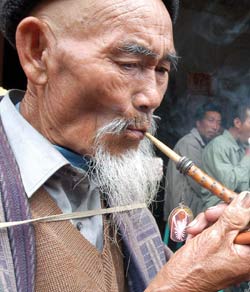| Putting the Shackle on Tobacco |
| http://www.sina.com.cn 2005/05/12 22:00 thats China |
In China, people like Zhang are few and far between and usually found in big cities, such as Beijing, Shanghai, Dalian and Guangzhou, where young people have come to accept that it is not "selfish" to protect one's health instead of catering to the bad habits of others. In smaller cities and rural areas, where smoking is most popular, people like Zhang can often find themselves quickly excluded from friendship circles. It is common etiquette in China that when a male guest visits, the first question often asked is "Would you like a cigarette?" It's considered improper not to ask, and worse to try to prevent your guest from smoking entirely. According to a 1997 report by Yang Gonghuan, around half of China's nonsmokers are secondhand smokers, with over 70 percent of these people, mostly women and children, exposed to secondhand smoke in the home. A 2004 survey conducted by Chinese and American scientists, published in the American Journal of Public Health, found the number of secondhand smokers hovering at 49 percent of the non-smoking population. Other evaluations estimate higher numbers, with 65 percent of nonsmokers suffering exposure to secondhand smoke, 85 percent in the home. Many of those among the 15 percent or so smoke-free, are young families who have abstained from or quit smoking to protect their children. Some Chinese experts predict that the number of smokers in China will decline by 100 million over the next 30 years, though no current evidence fully supports this forecast. Many Chinese have little awareness about the dangers of smoking, knowing only those three dry words "xiyan youhai jiankang" ("smoking harms health"), from the health warning printed on cigarette packages. Wang Xue, and Sun Lei are Beijingers in their thirties. They're both smokers and admit they know little about the detrimental effects of smoking. "The cigarette advertisement posters are more easily seen than the warnings of the risks of smoking," says Wang. Wang's reason for smoking is "just to relax." Both say they would kick the habit if they truly thought smoking harms their health.
"We are living in a sociably acceptable smoking world intentionally glorified by tobacco businessmen while learning little about the risks of such behavior. How can the number of smokers be expected to decrease? The first step is to educate and raise the public awareness," says Liu Hongming, who works in the media industry. Liu feels such a task would be quite a difficult battle. However, the barrier blocking the anti-tobacco drive is made of more than just the cultural acceptance of a behavior practiced in various forms for over 400 years. Tobacco taxation accounts for about 10 percent of China's national revenue every year, the largest source of revenue for the Chinese government. Among China's hundred largest taxpaying companies, 35 are state-run cigarette manufacturers. These companies are also major employers, providing jobs to about 60 million Chinese. In Yunnan for example, 70 percent of the provincial revenue is from the tobacco industry, and 1.79 million farmers make a living by planting tobacco leaf. Local officials remain ignorant of the long-term health impact and cost of treating smoke-related illnesses. Though losses in revenue due to tobacco restrictions could theoretically be offset by hiking taxes on tobacco products, the problem of how to find employment for 60 million tobacco workers is one without an immediate solution. "China is still a developing country," Zhu Xuancai, a researcher in the field of tobacco control, told Xinhuanet. "Tobacco control would require a large social costs and economic costs, but China isn't prepared to shoulder these costs. This is a key factor in the battle for tobacco control." The negative effects brought on by tobacco are meanwhile becoming more and more noticeable. Yang Gonghuan points out that lung cancer rates in China are soaring, at a greater cost to labor productivity. From 1991-2000, the rate of lung cancer deaths nearly doubled, and lung cancer is now China's most deadly form of cancer. "Up to one quarter of the government's tax revenue from tobacco sales is used to treat these illnesses," Yang notes. "If left to itself, the smoking population will rise to 430 million over the next 30 years, and questions of poverty and health will become more serious," says Yang.
|
| 【评论】【论坛】【收藏此页】【大 中 小】【多种方式看新闻】【下载点点通】【打印】【关闭】 |

